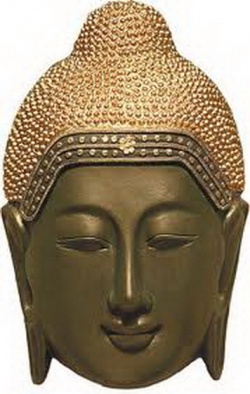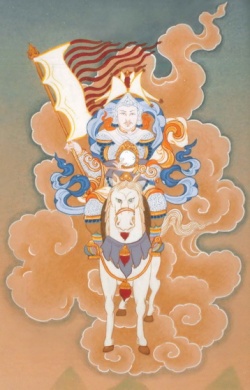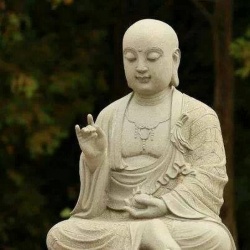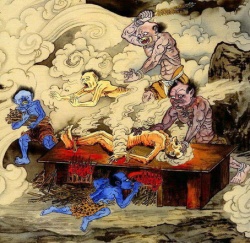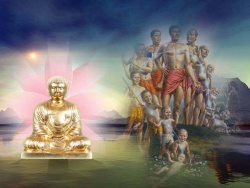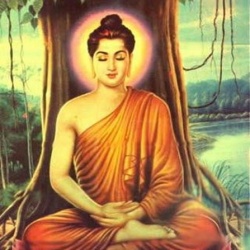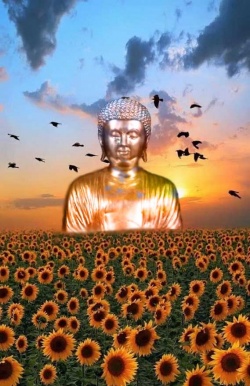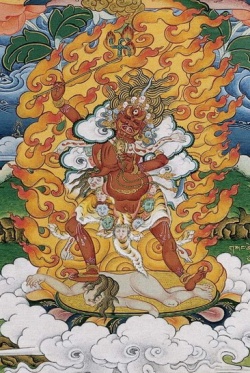The Lower Samadhis: Savitarka, Nirvitarka, Savichara, Nirvichara
by Swami Krishnananda
We were in the midst of the stages of samadhi, or samapatti as it is called in the Yoga System of Patanjali's. In laying the foundation of the very meaning of samadhi, I think I have taken enough time to explain the intricacies, the subtleties, and the profundities of this process.
It is not a sudden jump to reality that is taking place in one’s attempt to attain union with reality. Degrees of reality are accepted, evidently, in all schools of thought, West or East. There is a necessity to accept there being such a thing called an evolutionary process, and that each stage of the process is as real as any other. There may be a lower one, and there may be a higher one; it does not mean that only the higher stage is real, and the lower one is not. It is often said that the advance of human aspiration is not from untruth to truth, but from lesser truth to higher truth. Total negation of truth is not possible.
The categories of the Samkhya already enumerated are the principal themes of concentration in the system of Patanjali's. The stages according to the Samkhya, accepted by the Vedanta also, are, first of all, an infinite consciousness called by various names: Brahman, Purusha, the Absolute Substance, and so on. Then the potential for objective manifestation, which in the language of the Samkhya is known as Prakriti, the universal matrix of pure objectivity, about whose nature I mentioned earlier, is posited.
It may be difficult to conceive what this Prakriti is, because every name which is a noun and a substantive is generally taken to mean some existent ‘something’. Actually, intriguingly though, Prakriti is not a substantial, existent ‘something’, but a potentiality for objectification of what is otherwise universal. It is a mysterious force which cannot be defined in any language. There must be something operating, though we cannot know what it is, in order that the all-pervading Universal Being gets objectivised and made to appear as an external universe. That peculiar operation is known as Prakriti. It is not a substance, but a mode of operation.
Suppose one is ill. Illness cannot be regarded as a substance. It is not a solid object; yet, illness exists. Generally, by ‘existing’ we mean there is a perceptible ‘something’. But, a thing called disease, illness or fever cannot be perceived by any organ or any sensory means. It is, and yet it cannot be known except by the experience that something is abnormally functioning in oneself. This abnormality which cannot be regarded as an object, or a subject, or a substance, or anything whatsoever, yet operates like a fever in the body of a person, neither is, nor is not. It is indescribable. The fever exists, and yet we cannot see it or touch it; there is no substantiality in it, though it annoys us very much.
Such a kind of potential for externalization of the Universal is called Prakriti. So, the first is infinite consciousness, by whatever name it is called. Then, there is Prakriti, the potential for externalization. Then, there is a very mysterious, unthinkable reflection, as it were, of this Universal through the potential known as Prakriti, taking the name of Cosmic Consciousness; it is called Mahatattva in the language of the Samkhya. That is to say, in order that one may be omniscient, omnipotent, or omnipresent, there must be a sort of potential externality, like space. Unless there is something to know other than one’s own self, there is no question of omniscience; unless there is something other than oneself, over which one has to exercise power, omnipotence has no meaning; and, unless there is a spatial concept, omnipresence also cannot be explained.
The Ultimate Being cannot be called omnipresent, omniscient, and omnipotent. It is beyond these grand concepts of religion, because there is no space and time there. Yet, we conceive the Ultimate Reality as all-pervading, all-knowing, and all-powerful. This possibility has arisen on account of a peculiar conditioning of the Infinite Being through this externalising medium called Prakriti, breeding a situation called the Mahat or Cosmic Being, which becomes self-conscious and is known as Ahamkara. Very carefully you have to distinguish between this so-called metaphysical I-ness known as Ahamkara, and your or my feeling that “I am”, ahamkara. I mentioned that the usage of the same word for two different things is unfortunate. They could have used two different words.
However, a cosmic sense of ‘I’ is called Ahamkara. This particular thing becomes a tripartite existence: on the one hand, the subjective percipient; on the other hand, the objective universe; and a third thing, an intermediary connecting link called the divinity. I called these adhyatma, adhibhauta and adhidaiva. We shall not go into these details now, because our subject is samadhi.
When one attempts to concentrate on the basic lowest manifestation of reality, one confronts the physical universe. The direct attack by consciousness on this concept of physicality of the universe takes one by consternation, and we shudder at that time. Many a time in deep meditation people shake, feel a shock, and the whole body appears to be lifted up. This phenomenon takes place on account of the earlier incompatibility between individual beings and the Cosmic Being. When the individual existence attempts to unite itself with the Cosmic Being, it suddenly feels a shudder because the gradual melting away of the individuality of oneself is a very unpleasant experience to the ego principle which maintains this individuality.
No one likes to get subjected to the diminution of one’s self-respected individuality. But, meditation is nothing but a process of diminishing the quantum and even the quality of this individual ego principle, and so there is a blow given to it, as it were, by the entry of the Cosmic Being into the so-called subjectivity which we are endearing and hugging so much as our own true self, but which it is not.
The unpleasantness, the shock, the pain in the body, the difficulty in sitting for long in meditation are all excuses in the form of a malingering, as they call it, adopted by the ego: “I am not for it.” They say, when a war takes place, soldiers fall sick. That is called malingering. Somehow a reason is brought forth not to engage oneself in this arduous task.
To lose one’s individuality is not pleasant. It is a dear thing; we have been hugging it throughout ages. Now, we are trying to give a blow to it. We are bombarding the atom, as it were, and trying to release a tremendous energy out of it; and nobody likes to be bombarded.
So, in the very first instance of our attempt to introduce the cosmic element into the so-called perceiving individuality, we feel something strange is taking place. We do not know whether we are alive or dead, or whether we are on Earth or in heaven. All sorts of unpleasant experiences arise.
I mentioned yesterday that these are the so-called obstacles in meditation. The obstacles do not come from gods and demons, as tradition says. The gods and demons are within ourselves only. The potentials in our own personality, in all the layers of self-existence, manifest themselves outwardly, presenting pleasant conditions of temptation, and unpleasant conditions of threat and disaster.
Sometimes we feel that things in the world are very beautiful and happy, and we shall have them. In meditation, these tendencies present in us manifest themselves outwardly in space and time as beautiful things, tempting objects, celestial phenomena, etc. These temptations are the main obstacles. They are only the outer manifestations of our own inner liking for certain things in the world. And, there are certain things we do not like. They also manifest themselves outwardly as threats and disastrous consequences: “Beware! I shall put you down!”
In this connection, may I remind you of the wonderful experiences Buddha had when he was trying to attain his great samadhi. In the beginning, he was tempted with beautiful things – celestial taste, wonderful fragrance, softness. Who would not like to have that? Beautiful music and dance, and all celestial presentations were in his presence. Not only that, he saw his own wife, whom he had abandoned earlier. He was surprised that she could be in front of him when he was so far from the palace.
The conditions which relate the husband to the wife manifest themselves as this phenomenon. The lady herself had not come; she was in the palace. But there is a circumstance, or a potential relationship of husband to wife, which manifests itself externally as her presence. If a wife meditates, her husband will appear; if a husband meditates, his wife or even child will appear. Buddha withstood this temptation. He was strong enough to visualize what this was. “Get out from this place!” he said.
But the other potentials were also there, which he hated, and those hateful instincts manifested themselves as threats, groans, curses, noises and demoniacal forces saying, “I shall finish you just now, if you don’t get up from this place!” Buddha had great courage. He said, “If you want to finish me, finish me, but I shall not get up.” The beautiful temptation and the threat of unpleasant things will both present themselves to each person. If Buddha had it, everyone else also will have it.
In the Puranas there is the story of nectar, called amritamanthana, being churned out of the ocean. The gods and the demons churned the ocean in order to get nectar. But when they churned – which is comparable to the process of meditation that we are practicing – nectar did not come at all. Though the union with the Absolute is what we are aspiring for, it never comes. The opposite of it comes. Nectar did not come; poison came.
In the Puranas it is said that fourteen tempting things came, but first came a tremendous poisonous gas, suffocating and killing. These are the manifestations of the evil tendencies which everyone potentially has. No one in this world can be said to be a hundred percent good and wonderful. The evil tendencies also are there; they can be brought out by rubbing or scratching the person in the wrong way. They also come up and manifest themselves as poison.
In a similar manner is the experience that one has to pass through. What one has experienced, every other person also experiences because all are the same, as far as the individual constitution is concerned. There is no higher or lower; all are equal. So, all persons will have the same experiences. When we attempt to face the whole physical universe as our object of meditation and attempt to unite ourselves with it, a kind of lower samadhi ensues. In Patanjali’s language, this is known as savitarka samadhi.
This is a samapatti or a union that is accompanied by great personal effort. It does not happen spontaneously, like an apple falling from a tree. We have to struggle very hard, both intellectually and feelingfully. The intellectual and feelingful operation taking place at the time of this attempt to come in contact and in union with the whole physical universe is a tremendous experience indeed. The whole earth will shake. That is the lowest samadhi. This itself looks so wonderful and grand, but this most wonderful, intriguing and difficult-to-understand stage is regarded as the lowest of unions.
I am taking you stage by stage to the levels of samadhi, or samapatti, described by Patanjali's in his sutras. I am giving more details than what appears in the sutras, because a sutra is very short and, like a capsule, may have anything inside. But the capsule is a potential, and it is filled with certain ingredients which cannot be manifested outside. I am trying to explain what this capsule contains.
So, first and foremost is the experience of a most pleasant and yet difficult encounter with the cosmic physical existence, wherein you seem to be entering into the sea of the physical universe, and yetyou feel, at the same time, as if the waves of the sea are dashing upon you and pushing you back to the shore. When you try to enter the sea for taking a bath, you will see this kind of thing happening. On the one hand, you have the feeling that you are entering into the sea; on the other hand, there is a rebuff from the waves which will try to cast you out onto the shore.
This kind of struggle is characteristic of this lowest samadhi, savitarka samadhi. You are entering into the ocean of the whole physical universe, and at the same time, receiving a kick from this cosmos, because you have never been friendly with it at any time in your life. So, it shows its teeth: “You fellow, you never wanted me at any time. You ignored me completely. Now you want me? See what I can do for you. Come on! See my tiger-like face,” it will say.
You are frightened: “Oh, a tiger-like face! I don’t want it!” You would like to drop your samadhi and run away from that place. Nature can be called a tigress, if you want to call it that. It is very wonderful, very impartial, perfectly just, and yet looking like a fierce ogre, if you actually appear to go near it. Here, the samadhi, or the samapatti, that is accompanied by internal psychic struggle in overcoming the limitations of oneself, and allowing the Universal Being to enter into oneself, is savitarka samadhi.
Then comes another stage – something very mysterious, again. Though you are trying to unite your being with the whole cosmic existence in the nature of the universe, you cannot forget that this universe is in space and in time. Can you imagine a universe, minus space and time? No effort can permit you to disregard the interference of space and time. The whole universe is in space; this is what you are thinking. Go high, to the most distant stars which are many millions of light years away, but all this physical universe is inside space.
Newton, the great mathematician and physicist, thought that the whole universe is inside space, which was later refuted by further discoveries in science. The universe is not in space; it is something different. Yet, for all commonsense purposes, it looks as though it is in space.
Now, when you contemplate the whole universe as if it is in space and time, it is the lowest samadhi – savitarka. When you are struggling to obviate the interference of space and time and attack the universe as it is in itself, without any kind of association of space and time, that is nirvitarka samadhi, a higher state.
You can imagine how difficult it is. However much you may try to think that you are existing minus space and time, you will not succeed because you are always in space and time. Space and time have entered into the very fibre and constitution of the process of thinking itself, as the great German philosopher Immanuel Kant said. Space and time are not objects to be seen outside. They are the very constitutional essence of the process of thinking itself. You cannot think, minus space and time.
Here is a problem. If the mind is infested with the very concept of space and time, how could the mind think anything independent of space and time? Kant does not give the answer. Only the system of Patanjali's tries to answer.
When you think something, you naturally think of it as existing external to you, outside you – which means to say that it is in space. The externality of an object, something being outside you, is due to the fact of the intervening of space between yourself and that which you are thinking.
Suppose, as I mentioned earlier, the thing is yourself only. You have to think the world or the object as yourself, by aligning yourself with its being, thinking through its eyes, being through its being, and experiencing as it would experience itself. If the so-called object, which is appearing to be in space because of its outsideness from you, can become you, the distance between you and the object is abolished, and the space goes away. If you can adopt this technique in connection with the whole physical universe – the physical universe is not an object of contemplation, it is itself meditating – then, you are not meditating on the physical universe; the Cosmic Being, which is the physical universe, itself is meditating.
Where are you, then? You need not worry about all that. You have not to be there, because your being there is an interference. You are a kind of alien matter, an unnecessary interference, like an illness, as I mentioned. The universal physical universe does not want you to be there looking at it. Why? Because, you cannot exist minus that. The universe includes space, time and objects, which include yourself. You are also one of the objects, so who are you to go on looking at the universe?
If you can attempt this process and abolish the distance between yourself and the objective universe which you are contemplating, and you can accommodate yourself to the feeling that the Universal Being, the Cosmic Existence, the Universal Reality, the whole physical universe itself is thinking that it is, then this implies your entering into it as an inextricable, organic part.
In the second stage of samadhi, which is known as nirvitarka samapatti, the whole universe is conscious of itself. It is not that you are conscious of the presence of the universe. That stage is bypassed; you have transcended it, and should not think of it again. Because of the fact that you cannot stand outside the universe, you do not come into the picture at all. You have to abolish yourself, not by an effort of will on your part, but by a spontaneous acceptance that you cannot be outside the universe; then, a thrill enters into the experience.
Nobody can explain what that thrill is. Any amount of explanation, any word in the dictionary cannot explain what will happen to you. What is the universe thinking? That you will think. Can you ever imagine what the universe is thinking? With the farthest stretch of your imagination, you cannot tell me what the universe is thinking. It is thinking itself. It has nothing to think, because nothing is there except itself. “Thought thinking itself is God,” said Aristotle. “Thought thinking another is a human being.” You are entering into the portals of divinity. Stages of the Absolute are manifesting themselves before you.
In the encountering of the whole physical universe, the universe is contemplating itself, and the question of space and time does not arise because space and time are within the universe. So, why should it think of space and time? Such a wonderful experience! Even to hear this is a great joy. This comes to you as a great gift from the powers that be in this second stage of samadhi, known as nirvitarka samadhi. But this is not all. There is something more. However much you try to bale out the ocean with your bucket, the ocean will still remain as it was, and you will never exhaust its contents.
We noticed that the physical universe, as it appears, is not its essential nature; there are finer essences which constitute this vast panorama of the physical universe. These potential forces, which appear to be solid objects in the form of this physical universe, are the energy quantums spoken of in physics. In Sanskrit, these energy potentials are called tanmatras – the thatness of a thing, the suchness of a thing, or the whichness of a thing, as Buddhist psychology sometimes calls these potentials. You do not know what to call it – the suchness, whichness, thatness of the thing.
It is pure ubiquitous energy, with no undulations, with no ups and downs, all-pervading in the sense of itself alone being everywhere, and minus space and time, also. In the beginning, you are likely to feel that there is the movement of energy in space and time. The whole universe is energy, but this energy is inside space. This idea will not leave you. Okay, let it be. Even if you think that this universal energy, which is the basic substance of the physicality of the universe, is in space, it does not matter; attack it by your meditative consciousness.
The universe of physical appearance has gone now. You are facing pure energy. It is difficult to imagine. Nobody knows what energy actually is. You may say that it is like electricity, but what is electricity made of? It is energy; and what is energy? It is electricity. No definition is possible. It is just what it is.
Now you are in a state of concentration where you have given up the erstwhile feeling that the physical universe is made up of the sun, moon, stars, mountains, trees, rivers, etc. It is not. These are all outer manifestations of pure energy.
But the old habit persists and makes you feel that this all-pervading energy is inside space. This kind of union is known as savichara samadhi. These are all peculiar Sanskrit words indicating these conditions that I am explaining, and you may use any other word for it in your own language, if you like. Savichara samadhi is the higher experience of complete communion with the very essence of the physical universe, but you are pursued by this concept of space and time.
Can you feel that the energy is yourself only and, therefore, there is no necessity for space? The same technique that you adopted earlier should be adopted here in the case of the energy, also. You are not facing the universal energy; you are yourself the energy, because the whole bodily structure is made of pure energy. Therefore, this energy, which is you, is not meditating on the energy that is all-pervading. This energy that is the so-called ‘you’ has gone, melted into the energy that is really there – energy as it is in itself, which does not require to be called spatial or temporal. Minus the association of space and time, if you can identify yourself with the universal energy, abandoning the feeling that you are existing separately, you are in a samadhi called nirvichara samadhi.
Patanjali's seems to be wanting to extract the last pound of flesh from you, and he will not allow you to be in peace when he says that this, also, is not sufficient. You may be wondering what kind of Patanjali's this is: “However much I struggle and attain, he is says it is not sufficient.” Like the desires of a human being, he is never satisfied.
I do not want to proceed further. You have already attained a wondrous state. Can you maintain this feeling always when you are moving, talking, going to the dining hall, taking a bath, and going to the bazaar? Where is the bazaar? Where is the railway station? It is all very interesting. Can you maintain this great wondrous experience that you are hearing just now? If so, you will be the most blessed person in the world.
